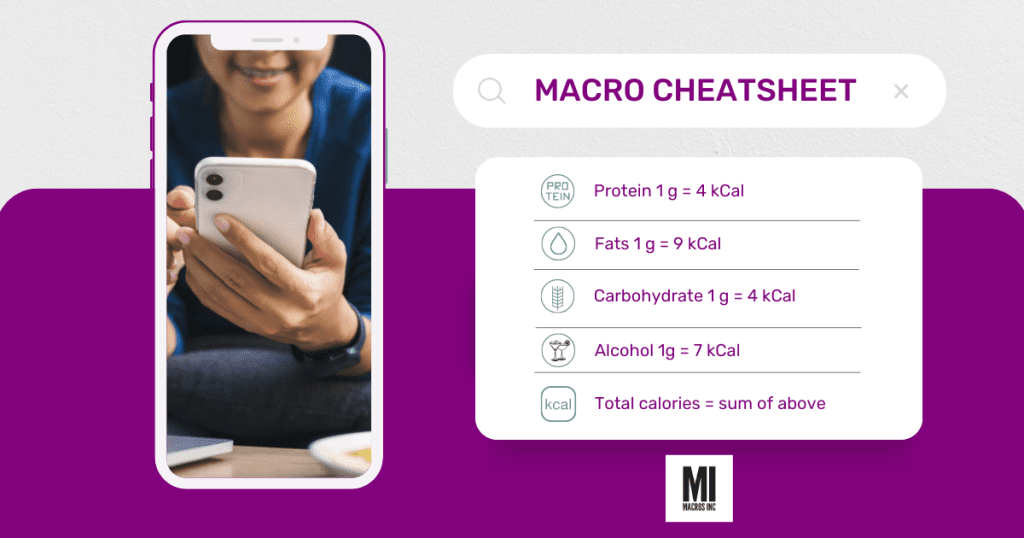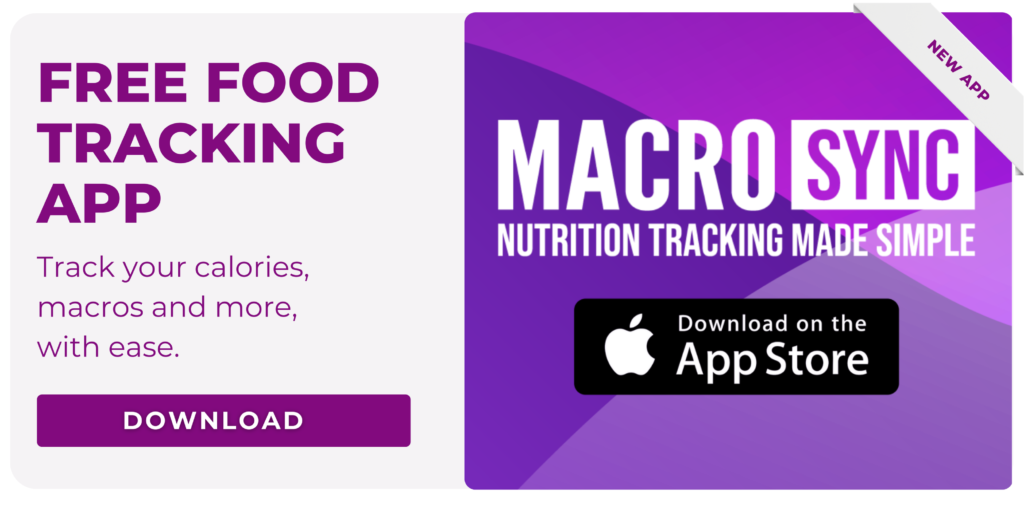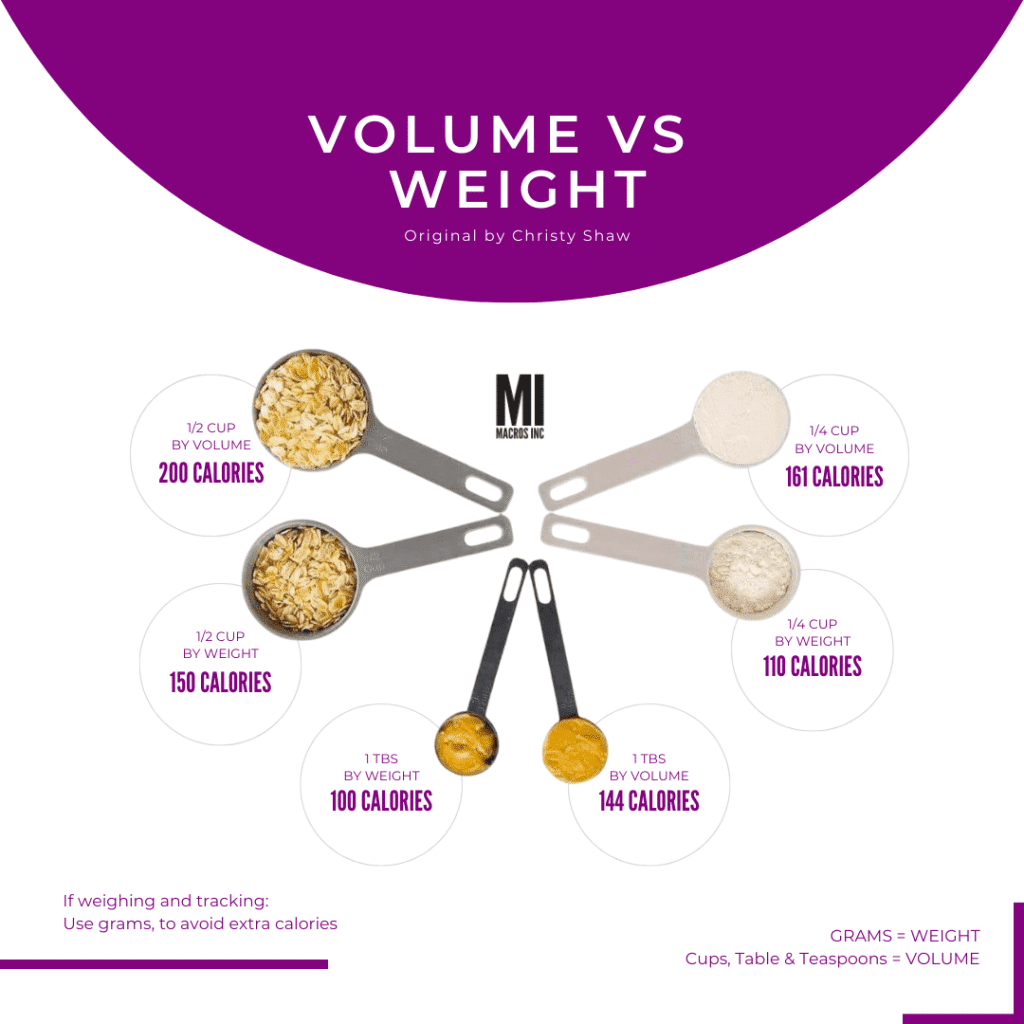In the world of fitness and nutrition, it’s not uncommon to hear the term “macros” being tossed around. But what exactly are macros, and why should you care about counting them?
If you’re looking to take control of your diet and make informed choices about your nutrition, understanding macros and learning how to count them can be a game-changer.
This comprehensive guide will walk you through the fundamental aspects of macros, macro counting, and provide you with practical tips on how to count macros effectively.
Whether your goal is to lose weight, gain muscle, or simply improve your overall health, mastering the art of macro counting can provide you with the foundation for achieving great results.
Jump to a Topic
What are Macros?
The term “macro” is simply short for the word macronutrient. A macronutrient is a nutrient that you eat in large quantities. This compares to “micronutrients” which we eat in small quantities. For example, we often eat 100 to 200 grams of protein in a day, whereas we consume 10-50 micrograms of vitamin D per day (100 grams is 100 million micrograms).
There are three macronutrients: protein, carbohydrates, fat, and alcohol is often considered the fourth macronutrient. .
Each of these macronutrients have different chemical structures (not really important right now) and have different primary functions (very important right now).
Protein
Protein is primarily used for structure and function in the body. It is used to make muscles, tendons, enzymes, antibodies, and all sorts of other pretty awesome things.
Carbohydrates
Carbs are primarily used as a fuel source for the body. They are used in large amounts by the brain and muscle tissue and many of your organs. You can store ~600 grams of carbohydrates in your body at any given time, which equates to ~2,400 calories.
Fats
Fats are also used as a source of fuel, but also are the main form of energy storage in the body. One pound of pure body fat represents ~4000 calories. So a 200 pound person at 10% body fat, stores around 80,000 calories of available energy in fat. Fat also plays many other roles such as providing structural support and is used in many hormones.
Alcohol
Alcohol can be classified as “the fourth macronutrient” because it is consumed in quantities similar to the other macronutrients and provides calories. Unlike the other macronutrients, alcohol supplies energy, but no real nutrition in terms of vitamins or minerals. Alcohol also behaves a little differently in our bodies compared to the other macronutrients. Specifically, when alcohol is present in our bodies, its metabolization is prioritized over the other macronutrients.
Calories of Each Macros
Each macronutrient also has a known “energy density”, meaning we know roughly how many calories our body is getting from each gram of macronutrient we eat. Here are the energy densities of each macronutrient:
- Protein: 4 kcals per gram
- Carbohydrates: 4 kcals per gram
- Alcohol: 7 kcals per gram
- Fat: 9 kcals per gram

What is Macro Counting?
What the heck is “macro counting” or “macro tracking”?
That is a great question. The answer is actually fairly straightforward, it is just a way to account for the food you consume in a day by counting how many of each macronutrient you are consuming in a day.
Think about it like your household budget. Each macronutrient is essentially a “line item” in your monthly household budget. So instead of having rent, utilities, groceries, and insurance, you track the grams and calories you consume between carbs, fat, protein, and alcohol and ensure that your total calorie intake (your total spend) is on budget!
Counting Macros vs. Counting Calories
Counting macros is a little different than counting calories in that it is a little more precise and makes sure you are getting the nutrients you need. For example, you could need 2,000 kcals in a day and if you counted just calories you could consume 2,000 kcals in movie theater popcorn and “be in budget”.
Counting macros ensures you are getting enough of each major nutrient (protein, carbohydrates and fat) to ensure you are working toward your body composition and weight goals.
How to Count Macros
In order to count macros you need just a few simple things to get started:
- An estimated target for your macros determined by a macro calculator
- An app or a notebook to track your macros
- A food scale and some measuring cups
Once you have those three things you are ready to start. There are many ways that you can begin, but generally the easiest way for people to start is to following this approach:
- Write down your macro goals from the calculator and then just eat a normal day of food and log the food either by reading the nutrition label or finding the food on the database of the tracking app you’re using. Make sure you’ve weighed your portion for an accurate measure of your macros.
- Look where your macros you consumed are off from your targets (i.e. are you over in fats and under in protein).
- Adjust your serving sizes the next day of the foods that are heavy on one type of macro. For example, increase your serving size of chicken to increase protein and decrease the serving size of your peanut butter to lower fats.
- Keep working on adjusting serving sizes for a few weeks until you find you are relatively close to your targets.
- Start working in different foods and meals that closely align with your targets.
An important caveat: all macro calculators are estimates and even the best ones can be a little off. You can get those numbers checked by a professional nutrition coach for free in our Facebook group to ensure they are ideal for you.

Counting Macros For Weight Loss
Counting macros for weight loss is not any different than counting macros for muscle gain, maintenance, or performance. However, there are a few concepts that people who are aiming for weight loss should consider that can often make it more effective.
The first is to overestimate on foods that you don’t 100% know the nutrients of. For example, if you go out to a restaurant and you can’t find the exact meal in your food tracking app, find a close one and then add 20% for the total calories. The same goes for any meal you are not sure about.
The second is that during weight loss, small errors can add up, so it is generally a much better idea to weigh your food instead of measuring it, especially dry goods as weight is way more accurate than volume.
Counting Macros For Muscle Gain
Muscle gain requires a surplus to build an appreciable amount of muscle, so counting macros for muscle gain has a few concepts that separate it from weight loss.
First, there is likely less margin for error in muscle gain if you are trying to gain lean mass and not fat mass. To build muscle you need a consistent surplus for months at a time.
Unlike weight loss where you can be in a deficit for two weeks and at maintenance for two weeks, to build muscle you need to be in a surplus essentially all the time. So consistency in tracking and maintaining a slight surplus is critical.
Second, is that precision actually becomes much more important because the window for optimal success is much smaller in muscle gain than in weight loss. The theoretical sweet spot for muscle gain and minimized fat mass gain is ~300 kcals to ~500 kcals or so per day.
This means that on a 3000 kcal “bulk”, you have maybe 10-15% error to be in the optimal range. Conversely, in fat loss, any deficit is good and effective. So making sure you are more accurate with weighing and measuring during muscle gain is incredibly important.
For Maintenance
Counting macros for maintenance looks very similar to counting macros for weight loss, with the exception of the “end goal”. Ideally, the goal with counting macros during maintenance is that you use it as a tool to build habits so you don’t have to track and count everyday.
If you can develop consistent eating patterns and meals you can follow those habits and maintain weight easily over months and years, with only occasionally needing to track to confirm your habits are still in line with your goals.
Tracking Alcohol Macros
There are several ways to track alcohol, with all of them being viable, and some being marginally more accurate than others.
The first way to track it is to simply use the entries of a commercially available food tracking app, such as My Macros+.
The second way is to track your alcohol as one of your other macronutrients, with logging it as carbohydrates or fat being more accurate than logging them as protein. The reason for this is that when you consume alcohol, the human body puts the “brakes” on metabolizing carbohydrates and fats, which makes it logical to label alcohol as either a fat or carbohydrate in terms of a macronutrient.
When we follow the second way of tracking alcohol, there are a couple easy paths to go down:
When tracking as a fat, divide the total calories of the drink by 9.
When tracking as a carbohydrate, divide the total calories by 4.
Or you can split the calories in half and then divide each half by 9 and by 4, respectively.
Here is a table that shows a few examples for a 300 calories drink:

In addition to the calories of the alcohol, make sure to include the calories of the carbohydrates and fats that are included in the drink.
Calories in Alcohol
Below are generic nutrition facts for standard drinks and associated serving sizes.
Beer (12 fl oz / 355 ml):
- Regular beer: 150-200 calories
- Light beer: 90-120 calories
- Craft beer: 180-300 calories
Wine (5 fl oz / 148 ml):
- Red wine: 120-125 calories
- White wine: 115-120 calories
- Rosé wine: 110-125 calories
- Sweet dessert wine: 160-220 calories
Champagne (5 fl oz / 148 ml): 90-120 calories
Spirits (1.5 fl oz / 44 ml):
- Vodka: 97-105 calories
- Gin: 110-120 calories
- Rum: 97-120 calories
- Tequila: 96-105 calories
- Whiskey: 105-120 calories
- Scotch: 105-120 calories
- Brandy: 90-100 calories
Liqueurs (1.5 fl oz / 44 ml):
- Amaretto: 160-170 calories
- Baileys Irish Cream: 140-160 calories
- Kahlúa: 90-110 calories
- Grand Marnier: 110-130 calories
- Frangelico: 100-110 calories
The Benefits of Counting Macros
There are substantial benefits to following a Macros based diet, especially from the perspective of education/learning, flexibility, and being able to control body weight effectively.
One of the greatest benefits people get from macro counting is that they develop a very deep understanding of the energy content and the nutrition that is present in the food they consume. You develop a set of skills and knowledge that you can use to look at a food and understand very quickly the total calorie content, the macronutrients, and even the micronutrients in that food from having tracked macros for weeks, months, or even years.
Food restriction is often one of the reasons that dietary adherence drops overtime. It is only possible to completely remove enjoyable foods from one’s diet for so long. A Macros diet allows people the flexibility to fit all types of foods into their diets if they are smart about how they account for them.
Developing an understanding of the energy and nutrition needs of your body and of the food you consume provides you the ability to manage and control your body weight effectively over the course of your lifetime as you can make adjustments to both your energy intake and your energy expenditure to reach desired goals.
What Should I Eat?
One of the greatest things about utilizing a system like counting macros for your diet is that you have a lot of flexibility in what you can eat. However, it is not meant as a way to eat a diet of highly processed, non-nutritious foods.
A commonly used phrase with flexible dieting is the “80/20” rule, meaning 80% of your diet should consist of whole, nutrient dense foods leaving 20% to be filled with more “fun” foods that you love but may not be the most nutritious choices.
The idea is that once you have fulfilled your body’s requirement for micronutrients and other nutrients like fiber, you can eat a little more flexibly since you can’t “stock up on the good stuff” by continuing to eat more once you’ve maxed out.
If you’re not sure of what foods to use to build a healthy plate, try following a macro cheat sheet or check out our macro-friendly cookbook or recipes!
Food Tracking Best Practices
Tracking food is a skill, and just like any other skill it takes a bit of learning the basics and then a lot of practice to develop. Here are some of the basics to learn so you can master the skills of tracking quickly.
Weighing vs. Measuring
A substance’s weight is a measurement of its mass, while volume is a measure of how much space the substance takes up.
Grams, ounces, pounds, tons are units of weight/mass. Fluid ounces (not the same as ounces!), milliliters, tablespoons, cups, gallons are units of volume.
In general, solid items should be weighed, and liquids should be measured.
While some scales do have a fluid ounce and/or milliliter setting, mass only equals volume when measuring water (1 oz = 1 fl oz), so it will be inaccurate to weigh liquids other than water even using fl oz or ml settings on a scale.
Use measuring spoons and cups for liquids.

Weighing Dry Goods
Packaged foods all have nutrition labels, and the nutritional information/macros on that label is always for how the food comes to you in the package. Food manufacturers pay to have a lab analyze the nutritional content of the food in the state that it is sold to you.
Therefore, the weight stated on the label of dry goods like pasta, rice, oats, grains etc., is for the uncooked product. You should weigh these items dry in order to have the macros on the package be accurate.
Weighing Meat
Meat is most accurately weighed and logged in its uncooked state. When you cook meat, water (and a small amount of fat) is cooked off, but the amount will vary depending on the method of cooking (baking vs crockpot vs a skillet etc.), and to what temperature you cook the meat. A rare steak will retain more water than a well done steak, for example, yet both are technically “cooked”.
The USDA has a database of essentially every cut of meat, fish and poultry and the raw macros for each. When you purchase meat at the store and there is a label on it, that label is for the raw product. So to use those macros when tracking, you must weigh it raw.
The USDA database also has cooked macros for most cuts of meat and fish. You can use these if you feel it is more convenient to weigh your meat after cooking, but remember that it will not be as accurate as raw because your method of cooking and level of doneness may vary from what was done to the cooked meat tested by the lab.
Some meat products, such as bacon, specify that the macros on the label are for the cooked product, so of course you should weigh it cooked.
Whether you weigh raw or cooked, the most important thing is consistency. Try and do it the same way, every time for best results and to limit the variability in your tracking.
10 Common Macro Counting Mistakes
When first starting to count Macros, or even as you become more comfortable there are some common mistakes that can impact your progress.
Generic tracking
When logging items it’s important to weigh them rather than log as 1 apple, or 1 banana as these things can vary greatly in size, weight and therefore calorie content. It is even worth weighing food that is pre-packaged due to discrepancies.
Volume vs weight
One misconception is that food can be measured in volume e.g scoops or cups. However this can be very inaccurate. Even foods that show servings in volume (protein powder we’re looking at you) usually show a weight next to this. With energy dense foods this can quickly add up to hundreds of calories in a week.
Eyeballing
This one goes without saying, eyeballing your food is very inaccurate for tracking purposes. If weight loss is your aim then you’ll need to stop eyeballing your food.
Weighing food cooked
Generally speaking in the case of meat products, the nutrition values are based on raw weight. Whilst your 200g chicken breast may only weigh 165g after being grilled, the only difference is a loss of water weight. Make sure you are weighing and logging raw wherever possible. Always check the nutrition information on the back of your items for the correct information.
Not tracking licks, bites and nibbles
We all do it. Those little tastes here and there can really add up and we’re notoriously bad at remembering we even did it. So take time to eat your food mindfully, sitting down and focussing on what you are eating.
Not tracking oils
The oils and fats you cook with, even the spray ones contain calories. Fats are 9cals per gram and not tracking the oil you use to cook can have a big impact on your overall calorie intake.
Eating out regularly
Eating out is one of life’s little pleasures, and we’re all about food freedom. But, when it comes to reaching your goals eating out can pose a real challenge for accurate tracking. Even when going by entries on menus, we recommend adding at least 20% extra calories to account for oils used when cooking and if possible minimize your meals out to help you stay on track.
Not tracking alcohol
Alcohol is its own Macro at 7 calories per gram, and those drinks can really add up particularly if you’re a fan of cocktails which usually contain sugar syrups and fruit juice. Make sure you include your alcohol intake in your tracking. If you’re in a calorie deficit and your alcohol is accounted for this won’t impact your progress.
Not creating custom entries for food
Labeling laws vary around the world, and many companies deduct fiber to make calories look lower. For this reason we recommend you create custom entries using the nutrition label for your food and of course weigh that item to see if it matches the packaged weight.
Eating back exercise calories
We all love our fitness trackers and getting those steps in is an excellent way to improve your overall health. However the calorie burn shown on these is inaccurate and for this reason you should disconnect your fitness tracker from your food tracking app. Your exercise and daily energy expenditure is already accounted for in the Macros we provide from our calculator.
Wrap Up
Understanding how to count macros is a powerful tool for achieving optimal nutrition and reaching fitness goals. By tracking and balancing macronutrient intake, you can tailor your diet to support weight loss, muscle gain or overall health and well-being.
When counting macros, it is important to determine individual macronutrient needs based on factors such as age, weight, activity level, and specific goals using a macro calculator. Utilizing a variety of resources such as food tracking apps, nutritional labels, and professional guidance can greatly simplify the process and ensure accuracy.
Remember, consistency and moderation are key when it comes to achieving and maintaining a healthy and balanced diet. By mastering the art of counting macros, you can take control of your nutrition, optimize physical performance, and enjoy a sustainable and fulfilling lifestyle
Try our nutrition coaching, for free!
Be the next success story. Over 30,000 have trusted Macros Inc to transform their health.
Simply fill out the form below to start your 14-day risk-free journey. Let's achieve your goals together!



